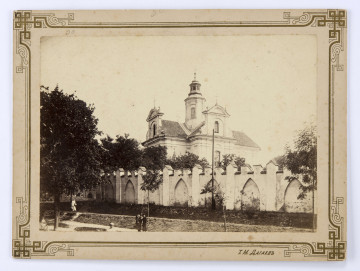
Postcard - Church in Kalinowszyzna
1899 — 1901
National Museum in Lublin
Part of the collection: Photographic iconography of Lublin from 1890–1939
In the second half of the 15th century, the Friars Minor of the Order of St. Francis, known in Poland as the Bernardines, settled in Lublin. The friars settled outside the city walls at the Church of the Conversion of Saint Paul the Apostle erected by the townspeople. With time, the wooden church was rebuilt into a brick one, which is linked to a legend about a chest of gold found in front of the Town Hall in the Old Town. The chest also contained a letter from an unknown donor to Mayor Jan Kwanta, ordering that the treasure be used to rebuild the Bernardine residence.
After a fire that ravaged Lublin in 1557, the Gothic buildings of the temple were destroyed. They were quickly rebuilt enough for a service to be held in 1569 to celebrate the Polish-Lithuanian Union. At the beginning of the 17th century, the church was destroyed by another fire. The restoration was led by the builders Jakub Balin and Piotr Negroni. The interior was decorated with beautiful Renaissance stucco vaults. Over the following centuries the body of the church was transformed.
Jan Ambroży Wadowski, the author of a monograph on the Lublin churches published at the beginning of the 20th century, described the activity of the Bernardines as salutary. "Fervent tellers of the word of God prudent confessors, they crushed the hearts of sinners," wrote the clergyman. Their estates were situated among gardens and near meadows on the Bystrica River. Over the centuries they enjoyed the support of influential people. One of the benefactors of the monastery was Wojciech Oczko, physician to the kings Sigismund II Augustus, Stefan Batory and Sigismund III Vasa, to whom an epitaph was dedicated inside the church. The Lublin voivode Marek Sobieski, grandfather of King John III, was also buried here.
Among the paintings in the church, the images of St Anthony (the patron saint of Lublin) and Tekla were particularly venerated. In 1818, the Bernardine Church held the largest funeral service in the city for the deceased Tadeusz Kościuszko.
After the fall of the January Uprising, the monks were removed from the premises they occupied. Their church, from then on commonly called the post-Bernardine church, was given to lay priests as a parish church. The space adjacent to the church used to be a cemetery. The nearby square, called Bernardine Square (today Liberty Square), was a market place. In the 1930s, the building of the current III Union of Lublin Secondary School was constructed in the neighbourhood.
Author / creator
Dimensions
cały obiekt: height: 20,4 cm, width: 15,2 cm
Object type
photography
Technique
sepia
Material
paper, cardboard, pencil
Creation time / dating
Creation / finding place
Owner
The National Museum in Lublin
Identification number
Location / status

1899 — 1901
National Museum in Lublin

1890 — 1910
National Museum in Lublin

1880 — 1900
National Museum in Lublin
DISCOVER this TOPIC
National Museum in Szczecin
DISCOVER this PATH
Educational path